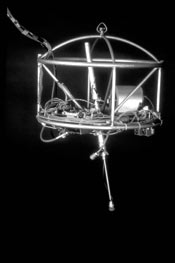2008 INDUCTEES
Raibert Hopper | NavLab 5 | LEGO® MINDSTORMS® | Lt. Cmdr. Data
Raibert Hopper
 When we say that someone moves robotically, it’s never a compliment. It’s another way of saying that the person is awkward, slow, clumsy, unnatural. Early walking robots, with their plodding gait, certainly fit that description. Though no one would describe the Raibert Hopper as human-like, experiments with the one-legged device in the early 1980s nevertheless showed how robots might someday walk, or even run, with the agility of a person.
When we say that someone moves robotically, it’s never a compliment. It’s another way of saying that the person is awkward, slow, clumsy, unnatural. Early walking robots, with their plodding gait, certainly fit that description. Though no one would describe the Raibert Hopper as human-like, experiments with the one-legged device in the early 1980s nevertheless showed how robots might someday walk, or even run, with the agility of a person.
When roboticist Marc Raibert established the Leg Laboratory at Carnegie Mellon in 1980 (he would move it to the Massachusetts Institute of Technology in 1986), he believed robots, just like humans, needed to rely on motion for stability – the principle of dynamic balance – if they were ever to become speedy. Statically balanced legged robots might avoid falling over when they stop, but they could never do much more than shuffle along.
The one-legged Hopper was ideal for studying dynamic balance because it could not stand still, but had to keep moving to stay upright. Matt Mason, director of the Carnegie Mellon Robotics Institute, says this work revolutionized thinking about walking robots: “The Raibert Hopper was the visionary effort that set the entire field of robotic locomotion in motion.”
The lessons learned with the Hopper proved central for biped, quadriped and even hexapod running. Raibert is now president of the robotic firm he co-founded, Boston Dynamics.





